Silver Power Blue Lightning 600W
by Christoph Katzer on August 27, 2007 6:00 AM EST- Posted in
- Cases/Cooling/PSUs
Temperatures
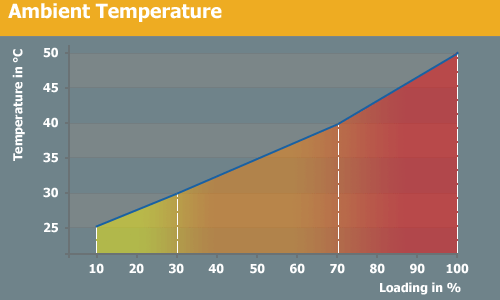
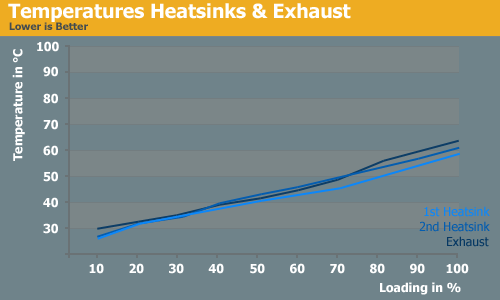
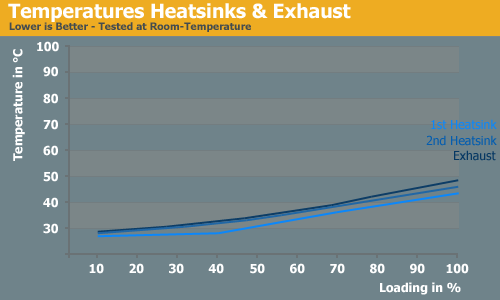
Our testing confirms our initial impression of the heatsinks. They dissipate heat quite well and manage to cool all of the components attached to them. Exhaust temperatures of only 50°C at 26° room temperature, even at maximum load, mean that users will have a relatively cool system. With a 50°C test environment, exhaust temperatures rise 15°C up to 65°C, while the heatsinks are only 10°C warmer than the ambient temperatures. These are fairly good results, but in a stress test environment temperatures are rising quite rapidly and we definitely would be cautious about using this power of supply in such an environment for an extended period of time. At normal room temperatures, the results are much better.
Fan Speed and Acoustics
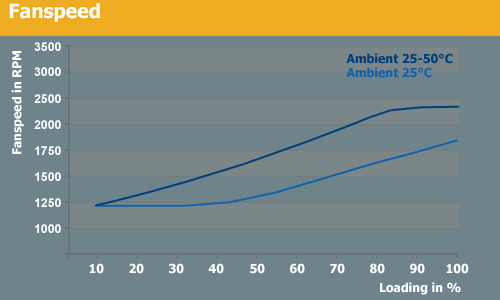
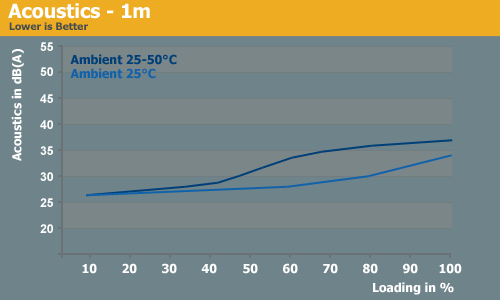
In our stress testing "heat chamber", fan speed is constantly rising up to the maximum speed of around 2400 RPM as the load and temperatures increase. At room temperatures, the fan holds a steady 1250 RPM up until about a 45% load. While the fan speed is definitely increasing, it's a bit unusual - and actually impressive - that the noise levels continue to stay relatively low, reaching a maximum of 37 dB at full load. Subjectively, the noise levels also agree with what we see on the charts: at maximum load the power supply isn't much louder it than at minimum load. Unfortunately, you can still hear the fan regardless of load, but once placed within a typical computer case the result should be a good, reasonably quiet system.



Our testing confirms our initial impression of the heatsinks. They dissipate heat quite well and manage to cool all of the components attached to them. Exhaust temperatures of only 50°C at 26° room temperature, even at maximum load, mean that users will have a relatively cool system. With a 50°C test environment, exhaust temperatures rise 15°C up to 65°C, while the heatsinks are only 10°C warmer than the ambient temperatures. These are fairly good results, but in a stress test environment temperatures are rising quite rapidly and we definitely would be cautious about using this power of supply in such an environment for an extended period of time. At normal room temperatures, the results are much better.
Fan Speed and Acoustics


In our stress testing "heat chamber", fan speed is constantly rising up to the maximum speed of around 2400 RPM as the load and temperatures increase. At room temperatures, the fan holds a steady 1250 RPM up until about a 45% load. While the fan speed is definitely increasing, it's a bit unusual - and actually impressive - that the noise levels continue to stay relatively low, reaching a maximum of 37 dB at full load. Subjectively, the noise levels also agree with what we see on the charts: at maximum load the power supply isn't much louder it than at minimum load. Unfortunately, you can still hear the fan regardless of load, but once placed within a typical computer case the result should be a good, reasonably quiet system.










33 Comments
View All Comments
Per Hansson - Monday, August 27, 2007 - link
If you take a DMM and measure the power drop on the actual molex connectors, and not take the results directly from the Chroma how does it look then?I suspect you have an exponential increase in resistance which causes the Chroma to display incorrect voltage values... (Because of the cable length from the PSU's connectors and up to your load, including interface boards)
Sincerely - Per Hansson
MrOblivious - Monday, August 27, 2007 - link
Well that and if this really is a Solytech (Deer) it could just be a flaming hunk of crap.Per Hansson - Monday, August 27, 2007 - link
Yea, but the voltage resistance issue is something that has been the same for all PSU reviews here at AnandWhen you have this problem with all PSU's you need to realize there is something wrong with your testing equipment, sorry for being so blunt... (Especially since none of the other 2 big sites report the same)
And yes, some scope readings for this DEER PSU sure would have been interesting (just to make sure to beat the dead horse a bit more)
Christoph Katzer - Tuesday, August 28, 2007 - link
Strange though that the Zippy G1 has nearly the whole time close to to 12.0v. I have seen reports from the companies and they look similar (also the high efficiency) and thus I don't think the resistance will be a big issue.MrOblivious - Tuesday, August 28, 2007 - link
Are they using a Chroma as well for those test reports? Or are they reading directly at the connector without another interface like the spec calls for?Christoph Katzer - Tuesday, August 28, 2007 - link
"Every" company in Taiwan uses Chroma for their own evaluations.Per Hansson - Tuesday, August 28, 2007 - link
Christoph Katzer; The issue is of course not that you are using the Croma, it's a great unit; however, the way you use it will most likely result in incorrect voltage readingsDue to the fact that the resistance in the cables loading the unit will most likely result in a exponential increase in resistance, therefore the results shown by the Chroma will be incorrect, and more incorrect as the load increases and the resistance exponentially increases...
Just putting a multimeter on an unloaded Molex connector, or, directly on the molex connector you are loading (and not further down where the chroma reads the voltage) would quickly prove or disprove my theory
mindless1 - Thursday, August 30, 2007 - link
You are correct, that a high enough current on too low a wire gauge does cause significant voltage drop, I have observed it many times myself particularly with some of the poorer PSU using 12V connectors with less than 18 ga. wires.However, similarly we can't just take the reading from an unused molex connector instead, as a PSU is spec'd to provide it's voltages at the load through the existing wiring harness. It is not necessary to try to evenly distribute that load across all the wire pairs in that harness as that is a practically impossible scenario for implementation running a system, so a bit of a derating factor is needed to appoximate the typical expected loads. IMO, a good start would be loading each supply wire at about 6A (not counting ground returns) up until the rating per rail is met, leaving some supply wires per rail unused when (sum of rail wires * 6A) > rated current per rail. Obviously some connectors and leads are more robust and necessary than others, for example a floppy connector should just be ignored while the 2 x n 12V CPU connector should always be used.
mindless1 - Thursday, August 30, 2007 - link
I meant, high enough current on too high, too small a wire gauge.JarredWalton - Tuesday, August 28, 2007 - link
But wouldn't regular PC components drawing power from a PSU result in the same sort of increase in resistance? (Note: I'm not at all an electrician, so I could be wrong. Just asking a question.)